
3490
.pdfIssue № 2(34), 2017 |
ISSN 2542-0526 |
According to the same law, the bending moments in the clutch of the span in the fourth of the span are distributed;
Fluctuation of the normal efforts in the clutch section of the arch is considerably different from the normal law. Identical deviation from the normal law is characteristic of the bending moment in the support section of the arch;
2. If a deviation of the bending moment in the support section of the arch has a negative asymmetry and values, large mathematical expectations of the value, have high probabilities, i.e. normal conditions in the clutch section of the arch have a positive asymmetry, large mathematical anticipation of the value, have low probabilities.
The use of the obtained data on the effect of a range of the deformation modulus Е on the cal-
culation efforts Sр in the typical sections of the arch depends on the distribution law of certain
efforts Si. If this factor is normal, the expression for a specific degree known in the reliability theory can be employed:
S p ms · s , |
(3) |
where β is the correction number of the standards. With a specific degree Р = 0.95 this parameter is accepted to be β = 1.64.
For deviations of the distributions of the evaluated parameters on the normal law the calculation efforts were calculated using fractiles of the chosen betadistribution using the mathematical software MathCAD.
The results of computing the calculation parameters of the efforts in the typical sections of the arch for the investigated example using the above calculation algorithms are listed in Table.
Data on the probabilistic calculations of efforts in the typical sections of the arch |
Table |
||||||
|
|||||||
|
Section |
|
|
Calculation characteristics |
|
||
Effort |
Mathematical |
|
Variation |
Distributuion, |
Calculation |
||
of the arch |
Standard |
||||||
|
anticipation |
coefficient |
asymmetry |
value |
|||
|
|
|
|
|
|
|
|
|
Support |
–348.5 |
1.79 |
0.51 |
Normal |
–349.3 |
|
|
Ка = –0.249 |
||||||
|
|
|
|
|
|
||
Normal |
Fourth of |
–267.7 |
1.32 |
0.48 |
Normal |
–274.4 |
|
Ка = 0.399 |
|||||||
effort, kN |
the span |
|
|
|
|
||
|
Clutch |
–447.8 |
0.54 |
0.18 |
Betalaw |
–447.9 |
|
|
Ка = –1.008 |
||||||
|
|
|
|
|
|
||
|
Support |
–18.2 |
0.35 |
1.9 |
Betalaw |
–18.8 |
|
|
Ка = –0.906 |
||||||
Bending |
|
|
|
|
|
||
Fourth of |
8.1 |
0.81 |
10 |
Normal |
9.4 |
||
moment, kNm |
|||||||
|
the span |
|
|
|
Ка = 0.399 |
|
|
|
Clutch |
–40.4 |
0.90 |
2.2 |
Normal |
41.9 |
|
61

Russian journal of building construction and architecture
Conclusions
The analysis of the results of the probabilistic calculations of the efforts in the typical sections of the arch listed in Table resulted in the following conclusions:
1. A deviation of the moments for most characteristics of the sections of bridges using a sandy filling considering fluctuations of the deformation module of the soil filling is insignificant, which is important for considering possible defects and damage [5]. Even with the variation coefficient of the deformation module νЕ = 31 % a deviation of normal efforts in all of the sections does not exceed 0.5 % and the fluctuation of the bending moments in most loaded by bending and clutch sections is 1.9—2.2 %. It is only in the fourth of the span where the bending moments are considerably lower that the variation coefficient is 10 %.
2. While conducting strength calculations of the arch ferroconcrete shells in the elastic environment, determined specification of the elasticity module will suffice.
References
1.Safronov V. S., Zazvonov V. V. Vliyanie deformatsionnykh kharakteristik peschanoy zasypki na nap- ryazhenno-deformirovannoe sostoyanie gruntozasypnykh mostov [The influence of the deformation characteristics of the sand backfill on the stress-strain state Protosenya bridges]. Stroitel'naya mekhanika i konstruktsii, 2010, no. 1, pp. 16––21.
2.Safronov V. S., Zazvonov V. V. Vliyanie temperaturnykh vozdeystviy na napryazhenno-deformirovannoe sostoyanie bessharnirnykh svodchatykh proletnykh stroeniy gruntozasypnykh mostov [The influence of temperature effects on stress-strain state hingeless vaulted spans Protosenya bridges]. Nauchnyy vestnik Voronezhskogo GASU. Stroitel'stvo i arkhitektura, 2011, no. 1 (21), pp. 107—116.
3.Safronov V. S., Zazvonov V. V. Raschetno-eksperimental'noe issledovanie napryazhenno-deformirovannogo sostoyaniya zhelezobetonnogo svoda gruntozasypnogo avtodorozhnogo mosta [Numerical and experimental investigation of the stress-strain state of reinforced concrete arch highway bridge groundshaking]. Stroitel'naya mekhanika inzhenernykh konstruktsiy i sooruzheniy, 2011, no. 2, pp. 49—55.
4.Safronov V. S., Domanov D. I. Otsenka vliyaniya kosiny proletnykh stroeniy zhelezobetonnykh mostov na risk razrusheniya normal'nykh secheniy balok s nenapryagaemym armirovaniem ot izgibayushchego momenta [Assessment of the impact of skew span structures of reinforced concrete bridges on the risk of fracture normal sections beams free of tension reinforcement from the bending moment]. Stroitel'naya mekhanika i konstruktsii, 2012, vol. 2, no. 4, pp. 85—91.
5.Safronov V. S., Petranin A. A., Petrenya E. N. Superelementnyy raschet v smeshannoy postanovke zhelezobetonnykh mostov, imeyushchikh defekty i povrezhdeniya [Super-element calculation in a mixed setting of concrete bridges with defects and damages]. Izvestiya vuzov. Stroitel'stvo, 1996, no. 6, pp. 103—110.
6.Seredin P. V., Glotov A. V., Domashevskaya E. P. e. a. Structural and optical investigations of AlxGa1xAs:Si/GaAs(100)MOCVD heterostructures.PhysicaB-condensedMatter,2010,vol.405,iss.22,pp.4607––4614.
62

Issue № 2(34), 2017 |
ISSN 2542-0526 |
UDC 624.014.27 : 624.046
D. M. Shapiro1, A. P. Tyutin2, V. A. Rodionov3
THEORY AND DESIGN SCHEME
OF ROAD ENGINEERING STRUCTURES FROM PIPE GROOVE
Voronezh State Technical University
Russia, Voronezh, tel.: +7-910-344-73-34, e-mail: davshap@mail.ru 1D. Sc. in Engineeting, Prof. of the Dept. of Structural Mechanics Ltd. «Center-Dorservis»
Russia, Voronezh, e-mail: cds@cds.vrn.ru 2PhD in Engineering, Leading engineer 3Leading engineer
Statement of the problem. Designing a welded tubular pile is a new competitive variety of retaining walls used in modern construction. Developing calculation method for designing and investigating such systems is an important issue.
Results. The article provides a description and algorithms of the developed method of calculating engineering structures from pipe groove within road engineering structures. The theoretical basics, description of design diagrams, sequence of the calculation by means of the finite element method, a set of tests to limit state are presented. A calculation example is given.
Conclusions. The solution of practical problems and algorithmization of calculation tribosphenic systems within the road engineering structures is obtained. The results of the study are suitable for use in calculations of other designs of flexible retaining walls of groove type.
Keywords: welded tubular pile, calculation, design, road retaining walls, bridge foundations.
Introduction
The last decade has seen engineering structures developing into a new direction when enveloping systems starting emerging as support walks from tubular welded piles [1—4, 6, 9, 10, 12, 17, 20]. They consist of a steel pipe and welded clutched joints (Fig. 1). An internal vacuum of the pipe is filled with sand-cement mix (5:1 ratio), monolith ferroconcrete or soil nuclear that is designed considering the length within the base.
© Shapiro D. М., Tuytin А. P., Rodionov V. А., 2017
63
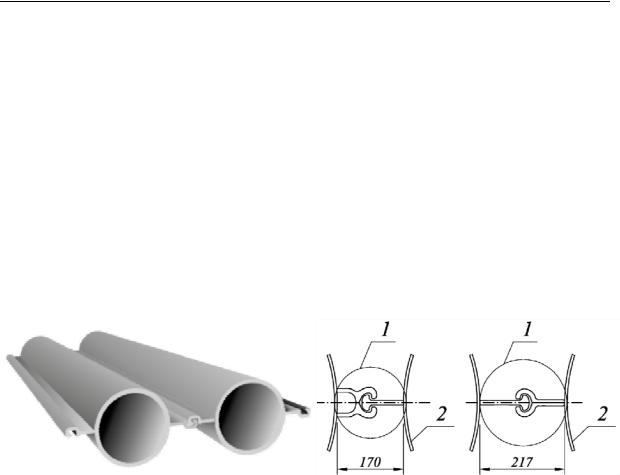
Russian journal of building construction and architecture
The advantages of tubular welded piles is a high level of ready-made quality, strength and simplicity of aligned joints, suitability for quick construction and operation in severe climate conditions. All of these make them particularly attractive for the use in construction as well as road industry: edge supports of bridges, supporting walls of the base, ramp areas of tonnels and other types of enveloping systems.
In the guidelines [5, 8, 16—19] there are theoretical foundations and general principles of calculating piled supporting walls requiring specification and extra information to be employed in projects. This article deals with practical tasks and algorithms of the developed engineering method of calculation for designing and studying engineering structures using tubular welded pipes.
а) |
b) |
Fig. 1. Structure of a tubular welded pile:
а) schemes of elements of welded tubular piles; b) examples of highly efficient clutch joints 1 [10]; 2 — tube
1. Theoretical foundations and description of calculation schemes. Calculations of road engineering structures are performed using limit states in two groups in accordance with GOST 27751-2014: in the first group (strength and bearing capacity) using calculation loads and strength characteristics of soils, in the second group (using transformations) by means of normal laods and strength characteristics of soils.
Calculations are performed in accordance with the conditions of a flat task (flat deformation). The calculation area (Fig. 2) is a segment of a designed structure with the width of 1 m restricted side vertical faces. Calculation schemes of tubular pile supporting walls 1 are replaced with flat rods of finite stiffness 2 with the calculation width of 1 m consisting of two areas: underground АВ and deepened into the base ВС.
The area АВ takes the active pressure of the soil from the side of the back face of a tubular welded pile, loads Р, Н, М applied to the head of an abutment (Fig. 2а) and eigen weight of supporting wall structures.
64
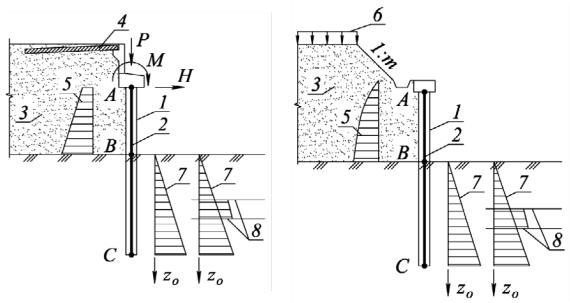
Issue № 2(34), 2017 |
ISSN 2542-0526 |
а) |
b) |
Fig. 2. Calculation schemes of road engineering structures using tubular welded piles: а) of an abutment of a bridge; b) of a road supporting wall;
1 — abutment (supporting wall); 2 — flat rod; 3 — filling behind the abutment, base of the road; 4 — intermediate plate; 5 — diagram of the active pressure of the soil; 6 —time road vertical load; 7 — distribution of the coefficient of the subbase Сz = KzО in a homogeneous and layer bases; 8 — boundaries of geological layers
The deepened lower part of the wall ВС is an operating area interacting with the base transmitting a horizontal and momentous loads. In order to describe a force impact of the soil and deepened part of tubular welded piles, a calculation scheme is used that combines the theory of the method of local elastic deformations with a triangular shapes of the distribution of the coefficient of the subbase and limit stress-strain of the soil.
The geometric characteristics of the sections are: area А, сm2/m, moment of inertia I, сm4/m, moment of resistance W, сm3/m, in extra calculations per 1 p. m. of a tubular welded pipes are determined depending on identical parameters of the sections of the pipes.
As the pipes are filled with a sand-cement mix or a soil nuclear
A |
1000 A |
, I |
1000 I |
|
, W |
1000 W |
, |
(1) |
|
D a D |
|
D a |
D |
|
D a D |
|
|
where АD, ID, WD are geometric characteristics of the sections of vacuum pipes with the thickness of the walls δ considering losses caused by corrosion; D and a are the sizes, mm (Fig. 3а).
65
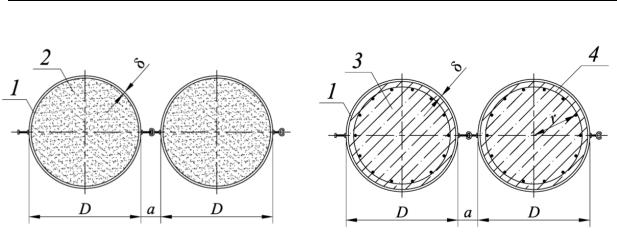
Russian journal of building construction and architecture
а) |
b) |
Fig. 3. Schemes of the sections of tubular welded walls:
а) a structure of tubular welded walls with a pipe filled with a sand-cement mix or a soil nuclear; b) a structure of a tubular welded piles with a tube filled with ferroconcrete;
1 — structure of tubular welded piles; 2 — sand-cement mix (soil nuclear); 3 — monolith ferroconcrete; 4 — reinforced frame
If pipes are filled with monolith concrete or ferroconcrete
A |
1000 |
A |
, I |
1000 |
I |
|
, |
(2) |
|
D a |
red |
|
D a |
|
red |
|
|
where Аred, Ired are the areas and moments of inertia approximated to steel of sections of the pipes determined using the following formula:
A |
|
D2 |
|
n |
1 |
A |
A |
, I |
|
|
D4 |
|
n |
|
1 |
I |
|
|
1 |
A r2 |
, |
(3) |
|
sb |
|
|
|
sb |
|
|
|
||||||||||||||
4n |
|
|
64n |
|
|
2 |
||||||||||||||||
red |
|
|
n |
|
D |
tot |
|
red |
|
|
|
n |
|
|
D |
|
tot |
|
|
|||
|
|
sb |
|
sb |
|
|
|
|
|
sb |
|
|
sb |
|
|
|
|
|
|
|
||
nsb = Еs/Eb is a ratio of the elasticity modules of steel and concrete; Atot is the area of the section of anoperatingreinforcementofferroconcreteusedfor;r istheradius ofareinforcedframe(Fig.3b). The calculation of a deepened part of the supporting wall relies on the following assumptions. 1. A deepened rod of finite stiffness replacing the supporting walls in a calculation scheme is divided into two parts: the upper one within which contact impact is determined with the limit resistance of рdeterm of the base and the lower one with a pressed, bent one according to the solution of a contact task using the method of elastic deformations.
The calculation is performed using the method of subsequent approximations with a step-wise displacement of the boundary between the above parts of a tubular welded wall. At the end of a calculation using the strength (in the first group) the height of a pressed part should be not less than ⅓ of the total height of the pressed part of the pile and not less than 5 m and at the end of the calculation using the displacements (the second group) is no less than ½ of the total height of the deepened part of the pile.
66
Issue № 2(34), 2017 |
ISSN 2542-0526 |
2. A force impact of the pressed part of the rod is assumed to interact with the soil environment and to be described with the function of the coefficient of the subbase Cz according to the equation
Cz KzО , |
(4) |
where K is the coefficient of the proportionality with the dimensionality kN/m4 depending on a type of a soil in accordance with the appendix V SP 24.13330.2011 of the size 1/3 of the values in Table В.1; zО is the coordinate of the length of the wall calculated from the surface of the base.
The coefficient of the subbase expresses the ratio of contact pressures рz and joint horizontal displacements уz of the pile and soil foundation:
Cz рz / уz . |
(5) |
The coefficient of proportionality can change at the boundary of geological layers in the base (Fig. 2). At the distance between the pipes а > 1,0 m the coefficient K is multiplied by the coefficient of the operating conditions:
с |
D 1 |
, |
(6) |
|
|||
|
D a |
|
|
where D and а retain its previous values and are expressed in meters. |
|
||
A horizontal load Рz per 1 meter of the width of the supporting wall is given by the ratio |
|
||
Рz рz 1 м Сz уz 1 м. |
(7) |
||
3. Contact pressures pz and the linear load Рz are restricted by corresponding limit values рdeterm, Рdeterm that are capable of perceiving the base:
pz pdeterm ,Pz Pdeterm . |
(8) |
The limit resistance of the base from the side of the front side of the piled supporting wall is determined as the difference between the passive pressure рp from the side of the front face and active pressure ра from the side of the back face of the supporting wall:
pdeterm pn pa |
(9) |
The limit linear load of the horizontal load on the base is as follows: |
|
Pdeterm pdeterm 1m (pn pa ) 1m. |
(10) |
4. The pressures рp and ра are identified based on the condition of the strength of the soil according to the Moht-Coulomb equation:
12 1 – 2 – 12 1 2 sin –c cos 0,
67
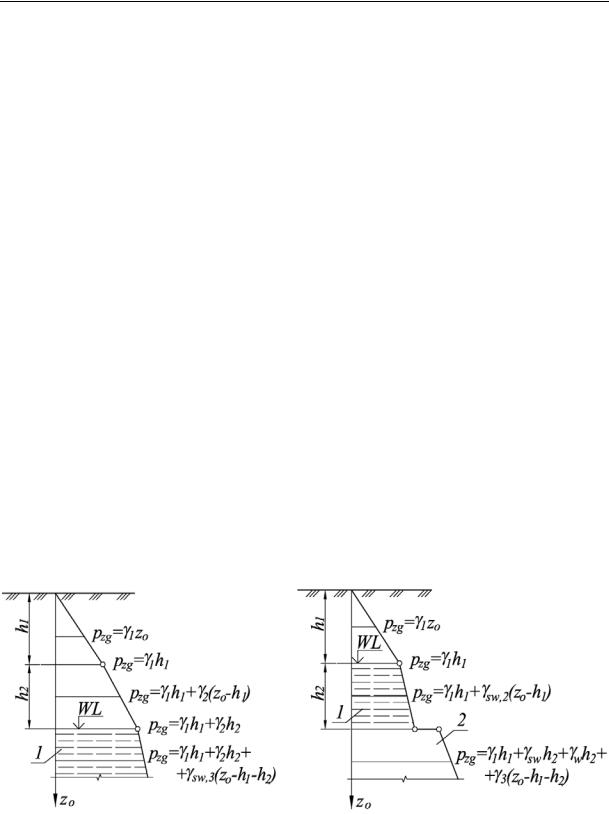
Russian journal of building construction and architecture
where σ1,2 the major stresses at the points (elementary volumes) of the soil on the contact (vertical) faces of the tubular piled supporting walls.
The fraction on the contact sides is neglected. Strains acting on these faces are major ones. The active ра and passive рp pressures of the soil on the vertical faces of the piled supporting walls is determined depending on the vertical pressure рv of the soil behind the lower supporting wall and natural pressure рzg of the soil of the base from the side of the front face of the supporting wall.
While determining the active pressure σ2 is replaced by ра, σ1 by на рv:
|
1 |
sin |
|
|
|
cos |
|
|
2 |
|
|
|
|
|
|
|
|
|
|
|
|
|
|
|
|
|
|
|
|
|
|||||||
pa pv |
|
|
|
2c |
|
|
|
pvtg |
|
|
45 |
|
|
2c tg |
45 |
|
. |
(11) |
1 |
sin |
1 |
sin |
|
2 |
2 |
||||||||||||
|
|
|
|
|
|
|
|
|
|
|
||||||||
While determining the passive pressure from the side of the front face of the supporting wall of the tubular welded pile in the base, σ1 is replaced by рп, σ2 by the natural pressure рzg:
|
1 |
sin |
|
|
|
cos |
|
|
2 |
|
|
|
|
|
|
|
|
|
|
|
|
|
|
|
|
|
|
|
|
|
|||||||
pn pzg |
|
|
|
2c |
|
|
|
pzg tg |
|
|
45 |
|
|
2c tg |
45 |
|
. |
(12) |
1 |
sin |
1 |
sin |
|
2 |
2 |
||||||||||||
|
|
|
|
|
|
|
|
|
|
|
||||||||
5. The distribution of the vertical pressure pzg from the weight of the soils of the base is accepted as specified in the schemes in Fig. 4 [7, 14]. In the upper layer as well as if the base is made more complicated by homogeneous soils with an evenly distributed specific weight,
pzg zО. |
(13) |
а) |
b) |
Fig. 4. Diagrams of the distribution of the vertical pressure pzg from eigen weight of the soils: а) in the bases with a varying specific weight along the depth if there are underground waters; b) in the bases partially weighed soil waters if there is a water-absorbing layer;
1 — water-absorbing soil; 2 — water-resistant layer of the base; WL is the level of underground waters
68
Issue № 2(34), 2017 |
ISSN 2542-0526 |
In the layer foundations with a varying specific weight and water absorbing soils if there are underground waters (Fig. 4а)
pzg |
1h1 |
2 |
(zО –h1), |
(14) |
|
pzg 1h1 2h2 sw,3(zО –h1 –h2), |
|||||
|
|||||
where h1, h2 are the thickness of the layers of the base within the depth zО; γ1, γ2 are specific weights of the bases of the layers of the base above the underground waters, γsw,3 is a specific weight of the layer of the water-absorbing soil determined as the weight of mineral particles, the indices 1, 2, 3 relate to the numbers of the layers of the soil.
In the water-absorbing layer of the bases the weight of the above layers and the weight of the layer of water are considered according to the scheme in Fig. 4b:
pzg 1h1 sw,2h2 wh2 3(zО – h1 – h2 ), |
(15) |
where γw = 9.8 kN/m3 is a specific weight of water, γ3 is a specific weight of the waterabsorbing layer.
6. The distribution of the vertical pressures pv behind the face of the supporting wall of the abutment of a bridge (Fig. 5а) is determined according to the following formulas:
–– within the filling behind the abutment (above the level of the planned surface): |
|
pv пz, |
(16) |
where γп is a specific weight of the abutment soil; z is a vertical coordinate calculated from the top of the filling behind the abutment according to the scheme in Fig. 5а;
–– within the base (below the level of the planned surface):
(17) The distribution of the vertical pressures pv behind the lower face of a road supporting wall in Fig. 5b is given by the following formulas:
–– within the filling (above the level of the planned surface):
p n z popen , (18)
–– within the base (below the level of the planned surface):
p n h popen pzg , |
(19) |
where h is the height of the underground part of the supporting wall (Fig. 5b); popen is a vertical pressure of the soil behind the lower face of the supporting wall from the weight of the sloped part of the abutment with the height d distributed according to the below expressions (21) that were obtained in the following way.
69
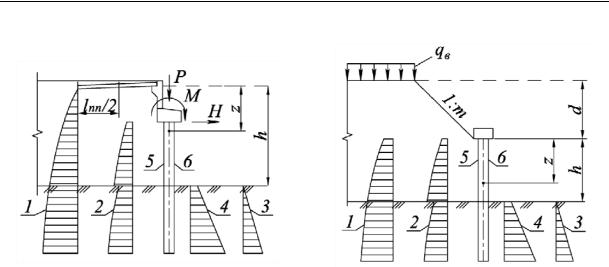
Russian journal of building construction and architecture
а) |
b) |
Fig. 5. Distribution of the pressures рv (1), ра (2)
on the back (5) and рzg (3), рf (4) on the front (6) faces of the piled supporting walls
Let us denote the intensity of the distributed load at the level AB on the left from the point D (Fig. 6):
qopen nd qb . |
(20) |
where qв is a temporary vertical load that is agreed to be evenly distributed on the surface of the base according to the GOST 32960-2014.
The vertical strains рopen behind the back face of the supporting wall are determined depending on qopen using the following approach that is similar to that in construction mechanics (the method of boundary elements). The essence of this method is to agree to expand the calculation area to the size and shape where there are ready-made solutions and to apply new boundaries of such a system of forces so that the distribution of strains on an actual surface of the calculation area with an acting load.
Let us show an example. The calculation area and an acting load are replaced with the equivalent system where the level of a horizontal face AB is displaced to the top at the height of ½md into the position A’B’. The acting load of a trapezoid shape is replaced by a band with the intensity qopen and is placed according to the scheme in Fig. 6. The total weight of the sloping part of the abutment and the equivalent load replacing it.
Let us draw two rays from the point Е at the angle of 450. One of them crosses the point В and the other one the point F. Let us assume that at the level AB the intensity of the load on the left of the point F is q open and on the right of the point changes according to the linear law to zero at the point В. Then the shape of the distribution of the load coincides with an actual shape of a part of the abutment.
70
